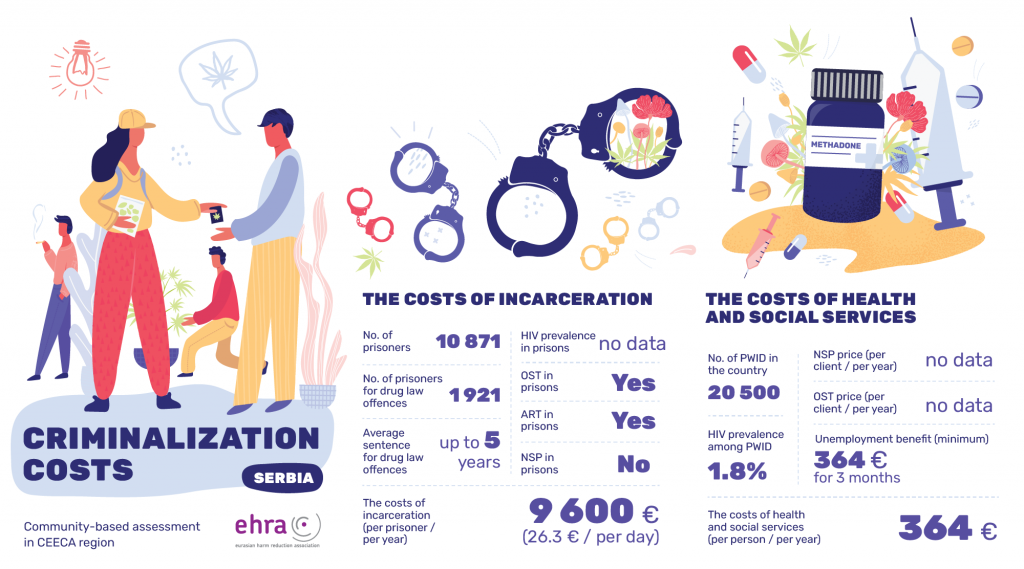As of 2019, there were 10,871 prisoners held in Serbia, of 1,921 were incarcerated for drug law offences [1]. Possession of small quantities of illicit drugs for personal use is punishable by up to 3 years in prison. Anyone who induces another person to take narcotics, or enables another person to use such drugs can be punished by imprisonment from between 6 months and 5 years [2]. No HIV prevalence data is available for prisoners in Serbia, although data reported in 2017 shows that 7 prisoners were living with HIV at that time [3]. Antiretroviral therapy (ART) and opioid substitution therapy (OST) – in the form of methadone – are both available in prisons, but needle/syringe programmes (NSP) are not [4]. In all prisons in Serbia, 413 people were receiving OST in 2014, and 487 in 2015. The ‘Special Prison Hospital’ has a mandate to initiate methadone treatment for inmates, with 343 people who use drugs receiving such support in 2014 and 320 in 2015 [5].
The Government of Serbia spends €9,600 on each prisoner every year, or €26.30 per day [6].
There were an estimated 20,500 people who inject drugs in Serbia in 2017 [7], [8] and HIV prevalence is estimated at 1.8% [9]. There is no data on the price of OST and NSP is Serbia. Unemployment benefit in 2019 was around €364 per person to cover a period of 3 months, or €121.33 per month [10]. Such benefit is only paid to a person who has completed 2 years of employment prior to making the benefit claim; such support is paid for 6 months following 5 years of employment, and 1 year of benefit payments if employment was for 10 years or more prior to the application for support [11].
As there are no NSP or OST costs available, the annual cost of providing support to a person who injects drugs in community settings is around €364 per year. This is considerably less than the €9,600 spent by the Government of Serbia each year to incarcerate such a person in prison. By decriminalising drug use and possession, the Government of Serbia could save €9,236 per drug user, per year, and up to a potential €16 million in total every year.
[1] Aebi MF, Tiago MM. SPACE I – 2019 – Council of Europe Annual Penal Statistics: Prison populations. Strasbourg; Council of Europe, 2020. https://wp.unil.ch/space/files/2021/02/200405_FinalReport_SPACE_I_2019.pdf (accessed 4 August 2021).
[2] European Monitoring Centre for Drugs and Drug Addiction (EMCDDA). Serbia National Drug Report 2017. Luxembourg; Publications Office of the European Union, 2017. https://www.emcdda.europa.eu/system/files/publications/4701/National%20drug%20report_Serbia.pdf (accessed 106 August 2021).
[3] Stöver H, Teltzrow R (eds.). Drug-Treatment Systems in Prisons in Eastern and South-East Europe. Strasbourg; Council of Europe, June 2017. https://www.emcdda.europa.eu/system/files/attachments/5502/Drug-treatment_systems_in_prisons_in_Eastern_and_South-East_Europe.pdf (accessed 3 August 2021).
[4] Harm Reduction International (HRI). Global State of Harm Reduction 2020, Regional Overview 2.2 Eurasia. London; HRI, 2021. https://www.hri.global/files/2020/10/26/Global_State_HRI_2020_2_2_Eurasia_FA_WEB.pdf (accessed 3 August 2021).
[5] EMCDDA, Ibid.
[6] Aebi M F, Tiago MM. SPACE I – 2020 – Council of Europe Annual Penal Statistics: Prison populations. Strasbourg; Council of Europe, 2021. https://wp.unil.ch/space/files/2021/04/210330_FinalReport_SPACE_I_2020.pdf (accessed 3 August 2021).
[7] EMCDDA, Op.cit.
[8] Kilibarda B, Mravcik V, Sieroslawski J, Gudelј J, Sebastian M. National Survey on life styles of citizens in Serbia, 2014. Key findings on substance use and gambling. Belgrade; Institute of Public Health of Serbia “Dr Milan Jovanovic Batut”, June 2014. https://www.batut.org.rs/download/publikacije/20140626IstrazivanjeStiloviZivotaE.pdf (accessed 10 August 2021).
[9] Joint United Nations Programme on HIV and AIDS (UNAIDS). Country factsheets, Serbia. Geneva; UNAIDS, 2020. https://www.unaids.org/en/regionscountries/countries/serbia (accessed 10 August 2021).
[10] Bjelotomic S. Serbia first in Europe in number of people employed for three months or less. Belgrade; Serbian Monitor/eastCOM Consulting, 19 November 2019. https://www.serbianmonitor.com/en/serbia-first-in-europe-in-number-of-people-employed-for-three-months-or-less/ (accessed 10 August 2021).
[11] Drašković V, Andrejević M, Bojović Drašković Popović & Partners. Employment and Employee Benefits in Serbia: Overview. London; Thomson Reuters Practical Law, 1 June 2021. https://uk.practicallaw.thomsonreuters.com/8-633-9487 (accessed 10 August 2021).

